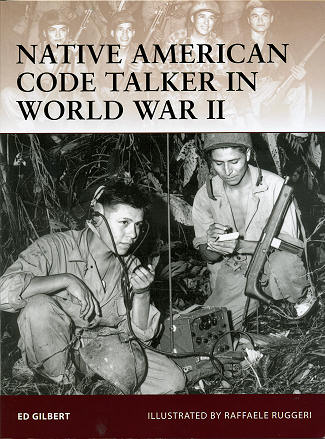 The most
recent addition to Osprey's Warrior series is this edition on Native American
Code Talkers. Though initially used in WWI during the last months of the war, it
is World War II that brought the true usefulness of this method of passing
needed information to the forefront.
The most
recent addition to Osprey's Warrior series is this edition on Native American
Code Talkers. Though initially used in WWI during the last months of the war, it
is World War II that brought the true usefulness of this method of passing
needed information to the forefront.
Basically, native Americans from the Navajo and Cherokee
tribes were used. There was a great deal of additional training done as many
technical terms did not exist in either languages. This required the use of code
words to be developed as well as ways of spelling out non-established words as
needed. These code words were also updated as time went on, requiring a constant
re-training syllabus so that talkers would be kept up to date.
It may seem unusual, but the army showed very little interest
in using code talkers. They felt that they could get their information across
just fine using mechanical means. It was the Marine Corps that found these
soldiers to be of the most use. Initially there was skepticism amongst field
officers as to the effectiveness of code talking, but when it was demonstrated
that a message that took hours to be coded, decoded and presented to the units
by machine could be done in minutes via code talking, most of that skepticism
faded away. Still, even in the Marines there were unit commanders who used code
talkers like ordinary communications specialists, squandering a very useful
asset to their command.
This book tells the story of these men. How they were
recruited, how they were trained and how they were used in combat. There is more
on the equipment they used, and how these men fit into the normal combat
scenarios, something quite unusual for Navajos who are, by choice, mostly
pacifists. There are sections on the Japanese attempts to break the codes,
something they were never able to do even though they had managed to capture and
brutally torture at least one man during the war.
There is further enhancement of the reading experience with
period photos and the illustrations of R. Ruggeri. It is a book that I know you
will find to be an excellent read and one that I can highly recommend to you.
April 2008.
For more on the complete line of Osprey books,
visit www.ospreypublishing.com. In the US, it is
Osprey Direct at 44-02 23rd St, Suite 219, Long Island City, NY 11101., where you can
get a catalogue of available books.
If you would like your product reviewed fairly and quickly, please contact
me or see other details in the Note to
Contributors.
 The most
recent addition to Osprey's Warrior series is this edition on Native American
Code Talkers. Though initially used in WWI during the last months of the war, it
is World War II that brought the true usefulness of this method of passing
needed information to the forefront.
The most
recent addition to Osprey's Warrior series is this edition on Native American
Code Talkers. Though initially used in WWI during the last months of the war, it
is World War II that brought the true usefulness of this method of passing
needed information to the forefront.